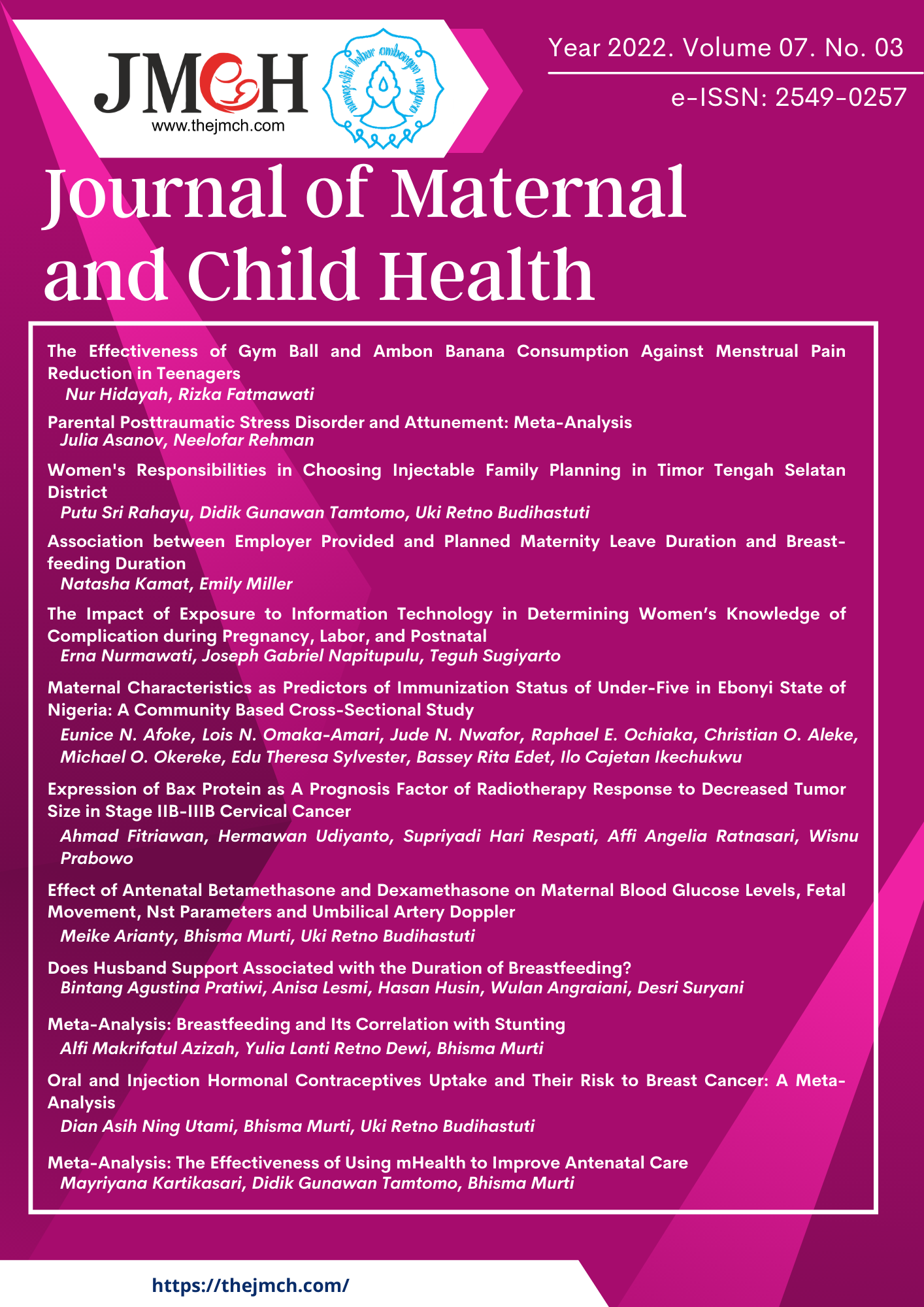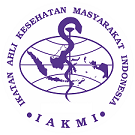Meta-Analysis: Breastfeeding and Its Correlation with Stunting
DOI:
https://doi.org/10.26911/thejmch.2022.07.03.10Abstract
Background: Stunting is a problem of chronic malnutrition in the first 100 days of life, which can be prevented by breastfeeding in children. This study aims to analyze the relationship between breastfeeding and the incidence of stunting based on the results of a number of similar primary studies previously.
Subjects and Method: This research was conducted using a meta-analysis study with PICO as follows: P= Children under five, I= Breastfeeding, C= Not Breastfeeding, O= Stunting. Article searches were conducted using electronic databases, namely PubMed, Goegle Scholar and Science Direct. Article searches were conducted using the keyword and Mesh methods as follows “Breastfeeding” AND “Stunting” AND “Children” “Breastfeeding and Malnutrition” OR “Breastfeeding Benefits”. sectional, the articles were analyzed using the Review Manager 5.3 application.
Results: There were 8 articles from the continents of Africa, Asia and South America which included Ethiopia, Rwanda, Tanzania, Zambia, Pakistan, Indonesia, and Ecuador from 2001-2022 which were analyzed using PRISMA flow diagrams. Research studies show that children who are breastfed have a risk of experiencing stunting as much as 0.62 times compared to those who are not breastfed (aOR= 0.62; CI 95%= 0.41 to 0.94; p= 0.020).
Conclusion: Breastfeeding can reduce the risk of children experiencing stunting.
Keywords:
breastfeeding, stunting, children under fiveHow to Cite
References
Anissa DD, Dewi RK (2021). Peran protein: asi dalam meningkatkan kecerdasan anak untuk menyongsong generasi indonesia emas 2045 dan relevansi dengan Al-Qur’an’ (The role of protein: breastfeeding in improving children's intelligence to welcoming the 2045 goldeni Indonesian generation and its relevance to the Al-Qur'an). Jurnal Tadris IPA Indonesia. 1(3): 427–435. doi: 10.21154/jtii.v1i3.393.
Bogale B, Gutema BT, Chisha Y (2020). Prevalence of stunting and its associated factors among children of 6-59 months in Arba Minch Health and Demographic Surveillance Site (HDSS), Southern Ethiopia: A community-based cross-sectional study. Journal Environ Health. 9520973. doi: 10.1155/2020/9520973.
Campos AP, Vilar-Compte M, Hawkins SS (2020). Association between breastfeeding and child stunting in Mexico. Ann Glob Health. 86(1). 145. doi: 10.5334/aogh.2836.
de Onis M, Borghi E, Arimond M, Webb P, Croft T, Saha K, De-Regil LM, et al. (2019). Prevalence thresholds for wasting, overweight and stunting in children under 5 years. Public Health Nutr. 22(1): 175–179. doi: 10.1017/S1368980018002434.
Fekadu Y, Mesfin A, Haile D, Stoecker BJ (2015). Factors associated with nutritional status of infants and young children in Somali Region, Ethiopia: a cross-sectional study. BMC public health. 15: 846. doi: 10.1186/s1288901521907.
Habimana S, Biracyaza E (2019). Risk factors of stunting among children under 5 years of age in the Eastern And Western Provinces Of Rwanda: Analysis Of Rwanda Demographic And Health Survey 2014/2015’, Pediatric Health Med Ther. 10: 115–130. doi: 10.2147/PHMT.S222198.
Hadi H, Fatimatsari, Irwanti W, Kusuma C, Alfiana RD, Asshiddiqi MIN, Nugroho S, et al. (2021). Exclusive breastfeeding protects young children from stunting in a low-income population: a study from Eastern Indonesia. Nutrients. 13(12): 4264. doi: 10.3390/nu13124264.
Kemenkes RI (2019). wartaKESMAS. gizi seimbang, prestasi gemilang (Balanced nutrition, brilliant performance). 01 edn. Jakarta: Kementerian Kesehatan Republik Indonesia.
Khan S, Zaheer S, Safdar NF (2019) Determinants of stunting, underweight and wasting among children < 5 years of age: evidence from 2012-2013 Pakistan demographic and health survey. BMC public health. 19(1): 358. doi :10.1186/s1288901966882.
Mgongo M, Chotta NAS, Hashim TH, Uriyo JG, Damian J, Pedersen BS, Msuya SE, et al. (2017) Underweight, Stunting and Wasting among Children in Kilimanjaro Region, Tanzania; a Population-Based Cross Sectional Study. Int J Environ Res Public Health. 14(5): E509. doi: 10.3390/ijerph14050509.
Murti B (2018). Prinsip dan metode riset epidemiologi (epidemiological research principles and methods). 5th edn. Surakarta: Program Studi Ilmu Kesehatan Masyarakat, Program Pascasarjana, Universitas Sebelas Maret.
Musisi S, Jacobson S (2015) Brain degeneration and dementia in Sub-Saharan Africa. New York: Springer.
Mzumara B, Bwembya P, Halwiindi H, Mugode R, Banda J (2018) ‘Factors associated with stunting among children below five years of age in Zambia: evidence from the 2014 Zambia demographic and health survey. BMC nutrition. 4: 51. doi: 10.1186/s4079501802609.
Nsereko E, Mukabutera A, Iyakaremye D, Umwungerimwiza YD, Mbarushimana, Nzayirambaho M (2018). Early feeding practices and stunting in Rwandan children: a cross-sectional study from the 2010 Rwanda demographic and health survey. The Pan African Medical Journal, 29: 157. doi: 10.11604/pamj.2018.29.157.10151.
Patole S (2021). Principles and practice of systematic reviews and meta-analysis. Switzerland: Springer Nature.
Sampe A, Claurita TR, Anung MM (2020). Hubungan pemberian ASI eksklusif dengan kejadian stunting pada balita (The relationship between exclusive breastfeeding and the incidence of stunting in toddlers) Jurnal Ilmiah Kesehatan Sandi Husada, 11(1): 448–455.
Sirajuddin, Asbar R, Nursalim, Tamrin A (2020). Breastfeeding practices can potential to prevent stunting for poor family. Enfermería Clínica. 30: 13–17. doi: 10.1016/j.enfcli.2020.02.007.
Teja M (2019). Stunting balita indonesia dan penanggulangannya (Indonesian toddler stunting and its management), Pusat Penelitian Badan Keahlian DPR RI, XI(22): p. 6.
Tello B, Rivadeneira MF, Moncayo AL, Buitron J, Astudillo F, Estrella, Torres AL (2022). Breastfeeding, feeding practices and stunting in indigenous ecuadorians under 2 years of age. International Breastfeed J. 17(1): 19. doi: 10.1186/s13006022004610.
Undang-Undang Republik Indonesia No 36 (2009). Undang-Undang Republik Indonesia Nomor 36 Tahun 2009 Tentang Kesehatan.
United Nations International Children’s Emergency Fund (2021) Malnutrition in children, UNICEF DATA. Retrieved at: https://data.unicef.org/topic/nutrition/malnutrition/ (Accessed: 17 September 2021).
WHO (2022) Breastfeeding. Retrieved from: https://www.who.int/westernpacific/health-topics/breastfeeding (Accessed: 23 February 2022).
Yuliarti N (2010). Keajaiban ASI - makanan terbaik untuk kesehatan, kecerdasan dan kelincahan si kecil. (The magic of breast milk - the best food for your little one's health, intelligence and agility.) Yogyakarta: Penerbit Andi.










